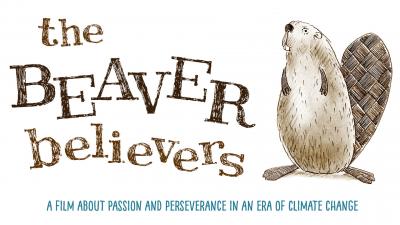Well good news for our chalk artist Amy Gallaher Hall. She hates to be penned in by barricade while she works but doesn’t love when her masterpiece is walked into either. I’m been scratching my head to try and find someone we can borrow a rope line and stanchions from but I found out yesterday that we can rent them pretty cheaply from Chairs for Affairs because people use them for crowd control at events or whatever. So Voila! Problem solved.
Also this ad featuring her art will be appearing in the Spring Bay Nature Issue:
 Amelia who does our brochure is back from Mexico fully tanned and rested and working on our new cover now. All is right with the world!
Amelia who does our brochure is back from Mexico fully tanned and rested and working on our new cover now. All is right with the world!
And things are looking pretty good for beaver world too. After the stellar report on beavers on the River Otter, and lots and lots of talk from the media, its seeming like pretty much a done deal. There’s a nice summary this morning from Associate Professor of Ecology at North Umbria University.
EXPERT COMMENT: Beavers are set to recolonise the UK – here’s how people and the environment could benefit
The results of the five-year trial are striking. The beavers built dams, creating wetland and ponds that slowed down peak river flows that might have caused flooding. Their engineering holds back water in the catchment area, stopping it from running off the land quickly and overloading the river, creating a bottle neck in towns downstream.
Th is glowing report on the flood prevention skills of beavers couldn’t be better timed. Two winter storms, Ciara and Denis, have recently brought flooding to thousands of homes in the UK. In November 2019, the National Trust, a charity more associated with stately homes, released beavers on Exmoor, also in Devon, with much of the publicity at the time touting the likely benefits they’ll bring to flood-prone homes nearby.
is glowing report on the flood prevention skills of beavers couldn’t be better timed. Two winter storms, Ciara and Denis, have recently brought flooding to thousands of homes in the UK. In November 2019, the National Trust, a charity more associated with stately homes, released beavers on Exmoor, also in Devon, with much of the publicity at the time touting the likely benefits they’ll bring to flood-prone homes nearby.
Wildlife has benefited from the beavers too. The small pools created by the dams had 37% more fish than comparable stretches of the river. That’s helped local birds that eat fish, while rare water voles have been able to find refuge from invasive mink in newly wetted channels. Young trout prefer the faster water of washed out dams and have been spotted leaping over intact dams during high river flows.
The River Otter backs up data from shorter term studies set over smaller areas that show beaver dams benefit the diversity of freshwater invertebrates, reduce nutrient levels in outflow, filter pollution and allow sediment to settle out and bury carbon.
Beavers look to be on the way back, all over the UK. Quite how they will get around isn’t entirely clear yet, but there seems to be widespread public and political support, and it may be that they will spread by themselves.

Beavers look to be on the way back, all over the UK. Quite how they will get around isn’t entirely clear yet, but there seems to be widespread public and political support, and it may be that they will spread by themselves.
People, landscapes and animals who need water need beavers. Period. Any other questions?



 Oh and lets throw out one more beaver shout to Jennalee Larson Naturalist Intern at Good Earth State Park in South Dakota. For some reason the Dakotas have always been smarter about beavers than lots of their neighbors. Well, mostly.
Oh and lets throw out one more beaver shout to Jennalee Larson Naturalist Intern at Good Earth State Park in South Dakota. For some reason the Dakotas have always been smarter about beavers than lots of their neighbors. Well, mostly.

 And just to demonstrate that beaver education is still needed. I will share one precious and shocking moment from a google search yesterday. You have my word that this was not photo-shopped in anyway and was captured on screen exactly the way it looked. Always remember, as foolish and inadequate as we all are, we’re at least better than this.
And just to demonstrate that beaver education is still needed. I will share one precious and shocking moment from a google search yesterday. You have my word that this was not photo-shopped in anyway and was captured on screen exactly the way it looked. Always remember, as foolish and inadequate as we all are, we’re at least better than this.


 We know that beavers are busy critters. They
We know that beavers are busy critters. They  Wet areas comprise just
Wet areas comprise just  Last year, Trout Unlimited asked the Bird Lab to help
Last year, Trout Unlimited asked the Bird Lab to help  The finished
The finished 




































